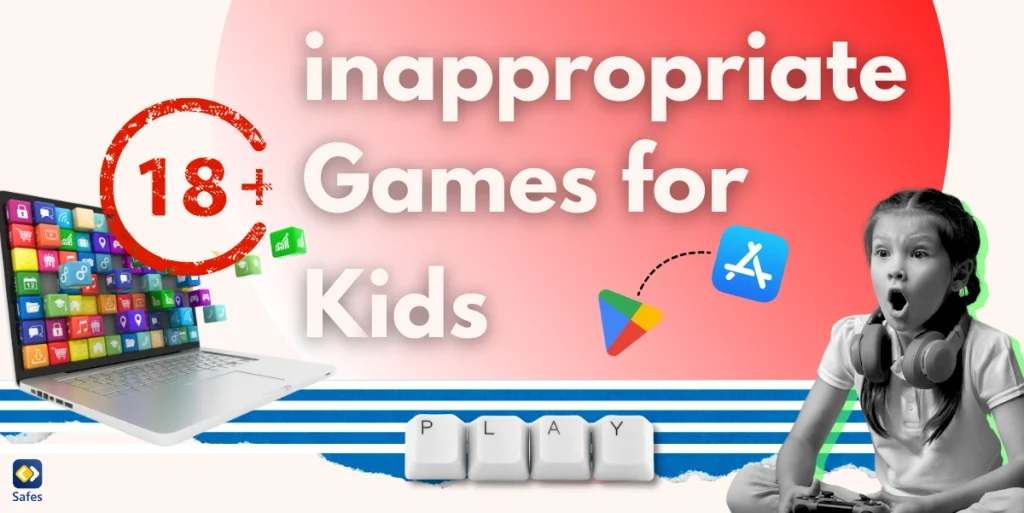Jeder Klick, Kommentar und jedes Teilen trägt zum digitalen Fußabdruck Ihres Kindes bei. Betrachten Sie es als eine Online-Spur, die seine Handlungen und Interaktionen widerspiegelt. Das Verständnis des Unterschieds zwischen einem positiven und einem negativen digitalen Fußabdruck ist entscheidend für seinen Online-Ruf und seine zukünftigen Chancen.
Wenn Sie als Eltern Ihrem Kind dabei helfen, einen positiven digitalen Fußabdruck zu hinterlassen, kann das einen großen Unterschied im Leben des Kindes bewirken. Eine positive Online-Präsenz öffnet Türen zu Bildungs- und Berufschancen. Umgekehrt kann ein negativer digitaler Fußabdruck zu Problemen wie Cybermobbing und Datenschutzrisiken führen oder die Zulassung zum College und die Berufsaussichten beeinträchtigen.
Indem Sie Ihren Kindern verantwortungsbewusstes Online-Verhalten beibringen, helfen Sie ihnen, eine sichere Grundlage für ihre Zukunft zu schaffen. Die Förderung einer bewussten Internetnutzung schützt sie heute und sorgt dafür, dass sie einen positiven digitalen Fußabdruck hinterlassen, der ihnen in den kommenden Jahren zugutekommt. Diese frühen Lektionen in digitaler Verantwortung können nachhaltige Auswirkungen haben und die Art und Weise prägen, wie sie im Alter online interagieren.
Was ist ein digitaler Fußabdruck?
Ein digitaler Fußabdruck ist eine Spur, die wir mit jedem Klick, Post oder jeder Suche hinterlassen. Für Kinder umfasst er jede Online-Aktion, auch solche, von denen sie vielleicht nicht wissen, dass sie öffentlich sind. Im Wesentlichen ist ein digitaler Fußabdruck für Kinder wächst durch alles, vom Posten von Kommentaren bis zum „Liken“ des Fotos eines Freundes – Aktionen, die vielleicht klein erscheinen, sich aber mit der Zeit zu einen Riesigen Fußabdruck summieren.
Es gibt zwei Arten digitaler Fußabdrücke: aktive und passive. Ein aktiver digitaler Fußabdruck umfasst die Dinge, die Kinder absichtlich online posten, wie etwa ein Profilbild oder einen Kommentar zu einem Beitrag eines Freundes. Ein passiver Fußabdruck hingegen besteht aus Daten, die im Hintergrund geteilt werden – wie etwa Standort oder Suchverlauf – und die bei jeder Verbindung mit dem Internet gespeichert werden.
Um einen positiven digitalen Fußabdruck zu hinterlassen, müssen Kinder lernen, im Internet achtsam zu sein. Positive Beispiele für einen digitalen Fußabdruck sind das Teilen kreativer Projekte, die Teilnahme an Lerngruppen oder sogar das Feiern der Erfolge von Klassenkameraden. Die Förderung rücksichtsvoller Online-Gewohnheiten hilft beim Aufbau einer digitalen Präsenz, die Türen öffnen und sie beim Heranwachsen schützen kann.
Lassen Sie uns fünf Möglichkeiten erkunden, wie Eltern einen positiven Fußabdruck bei ihren Kindern hinterlassen können.
Informieren und befähigen
Mit Kindern über Online-Sicherheit und Datenschutz zu sprechen, ist eine der besten Möglichkeiten, ihre digitalen Gewohnheiten zu steuern. Wenn diese Gespräche offen und vorurteilsfrei geführt werden, fällt es ihnen leichter, Fragen zu stellen oder Bedenken zu äußern. Diese Offenheit schafft Vertrauen und ermutigt sie, im Laufe ihrer Entwicklung über ihre Online-Erfahrungen zu sprechen.
Wenn es darum geht, einen sicheren digitalen Fußabdruck zu hinterlassen, können Sie Ihren Kindern ein paar wichtige Sicherheitstipps für den digitalen Fußabdruck geben. Ermutigen Sie kleine Kinder, keine persönlichen Informationen wie Privatadressen oder Schulnamen weiterzugeben. Wenn sie älter werden, bringen Sie ihnen bei, die Auswirkungen jedes Posts zu bewerten und zu überlegen, ob er Respekt für sie selbst und andere zeigt.
Kinder können lernen, gute Entscheidungen zu treffen, indem sie praktische Strategien anwenden, wie zum Beispiel die Regel „Erst denken, dann posten“. Ermutigen Sie sie, innezuhalten und zu überlegen, ob ein Beitrag etwas ist, auf das sie später stolz sein können. Wenn Sie Kindern diese durchdachten Richtlinien an die Hand geben, können sie Schritt für Schritt aktiv eine positive Online-Präsenz aufbauen.
Seien Sie ein Vorbild
Kinder imitieren oft, was sie sehen, weshalb es sehr wirkungsvoll sein kann, positives Online-Verhalten vorzuleben. Wenn Kinder sehen, dass ihre Eltern online respektvoll und rücksichtsvoll sind, ist es wahrscheinlicher, dass sie ihrem Beispiel folgen. Dieser Ansatz baut natürlich ihre Social-Media-Kompetenz und gleichzeitig positive Online-Entscheidungen im Alltag zu fördern.
Eltern können auch eine „digitale Fußabdruck-Aktivität“ einrichten. Nehmen Sie sich Zeit, damit jeder gemeinsam als Familie seine Online-Profile durchgeht. Sehen Sie sich Beiträge, Kommentare und Bilder an und besprechen Sie, wie eine positive digitale Präsenz aussieht. Diese Aktivität hilft Kindern, ihre eigene Wirkung zu verstehen und sich online bewusster zu fühlen.
Das Teilen Ihrer eigenen Online-Erfahrungen kann einen bleibenden Eindruck hinterlassen. Besprechen Sie Situationen, in denen Sie wohlüberlegte Entscheidungen getroffen oder aus digitalen Fehltritten gelernt haben. Geschichten wie diese vermitteln Lektionen, die hängen bleiben, und zeigen Kindern, wie reale Werte einen positiven digitalen Fußabdruck hinterlassen können.

Legen Sie klare Grenzen und Richtlinien fest
Wenn Sie Grenzen festlegen, was online geteilt werden darf, hilft das den Kindern, zu verstehen, wie sie mit ihrer Präsenz umgehen können. Entscheiden Sie gemeinsam über Dinge, die Kinder nicht auf Instagram posten sollten (oder jede andere Social-Media-Plattform), wie persönliche Informationen oder Fotos an bestimmten Orten. Diese Richtlinien bilden eine Grundlage für sicheres und durchdachtes Teilen, was ihre Online-Gewohnheiten prägen kann.
Eine Familienvereinbarung zum digitalen Verhalten kann Online-Sicherheit zu einer gemeinsamen Aufgabe machen. Führen Sie eine regelmäßige Überprüfung des digitalen Fußabdrucks durch, bei der jeder seine Konten überprüft, um öffentliche Posts und Einstellungen im Auge zu behalten. Diese einfache Gewohnheit ermöglicht es jedem, sich seiner Online-Auswirkungen bewusst zu sein und gleichzeitig ein Gefühl der gemeinsamen Verantwortung zu vermitteln.
Um die Überwachung zu vereinfachen, sollten Sie Tools in Betracht ziehen, mit denen Sie die Online-Aktivitäten Ihres Kindes verfolgen und verwalten können. Ressourcen wie Apps zur Kindersicherung oder die Browsereinstellungen ermöglichen Ihnen die Überwachung ihres Online-Fußabdrucks und führen sie behutsam zum Aufbau einer sicheren, positiven Präsenz, ohne dass Sie sich dabei zu eingeschränkt fühlen.
Safes: Ihr Partner für die Kindersicherung
Die elterliche Kontrolle ist der Schlüssel, um Ihrem Kind zu helfen, einen positiven digitalen Fußabdruck zu hinterlassen, und hier kommen unsere Safes ins Spiel. Safes bietet Tools zur Überwachung und Verwaltung der Online-Aktivitäten Ihres Kindes und verstärkt die von Ihnen festgelegten Grenzen und Richtlinien. So wird sichergestellt, dass Ihr Kind beim Navigieren in der digitalen Welt kluge Entscheidungen trifft.
Möchten Sie Safes ausprobieren? Wir bieten eine Kostenlose Testversion damit Sie sehen können, wie es die digitale Reise Ihrer Familie unterstützt. Der Einstieg ist einfach – Downloads sind auf beiden verfügbar iOS und Android. Mit Safes können Sie Ihrem Kind einen sicheren und positiven Umgang mit dem Internet vermitteln.
Fördern Sie positive Beiträge
Wenn Sie Ihre Kinder dazu ermutigen, einen positiven digitalen Fußabdruck zu hinterlassen, können Sie ihre Online-Erfahrungen bereichern. Schlagen Sie ihnen Aktivitäten vor, bei denen ihre Kreativität und Freundlichkeit zur Geltung kommen, wie z. B. das Teilen von Tipps zu einem Hobby oder das Posten unterstützender Kommentare zu Posts von Freunden. Wenn sie aktiv auf aufbauende Weise beitragen, bauen sie einen Ruf auf, der auf Positivität beruht.
Um Kindern zu helfen, eine starke digitale Präsenz zu entwickeln, führen Sie altersgerechte Aktivitäten ein, die sie dazu ermutigen, sich sinnvoll zu engagieren. Sie könnten sich ehrenamtlich bei einem Gemeinschaftsprojekt engagieren, Umweltschutzbelange unterstützen oder sogar einen Blog über ein Lieblingsthema schreiben. Diese Aktivitäten prägen ihre digitale Identität auf eine Weise, die ihre Werte und Interessen widerspiegelt.
Erinnern Sie sie daran, wie einfach es ist, online Freundlichkeit zu zeigen. Wenn Kinder lernen, mit Empathie zu kommentieren und andere respektvoll zu behandeln, schaffen sie einen Online-Raum, in dem sich alle sicher fühlen. Diese kleinen Aktionen bilden die Grundlage für einen positiven digitalen Fußabdruck, der mit der Zeit mit ihnen wachsen kann.

Regelmäßig überprüfen und aufräumen
Regelmäßige Überprüfungen der digitalen Fußabdrücke sind unerlässlich, um die Online-Präsenz sauber und sicher zu halten. Nehmen Sie sich als Familie Zeit, um Beiträge, Tags und Kommentare durchzusehen. Diese Überprüfungen helfen Ihnen, veraltete oder unangemessene Inhalte zu erkennen, sodass Sie gemeinsam eine positive Online-Präsenz aufrechterhalten können.
Die Überwachung muss sich nicht wie Polizeiarbeit anfühlen – es kann eine Familienaktivität sein, die das Bewusstsein fördert. Zeigen Sie Ihren Kindern, wie sie online nach ihrem Namen suchen können, um zu sehen, was angezeigt wird. Indem sie gemeinsam ihren digitalen Fußabdruck überprüfen, erhalten sie wertvolle Einblicke, wie jeder Beitrag oder Kommentar ihren Ruf prägt.
Erstellen Sie eine Checkliste, die ihnen hilft, ihren digitalen Fußabdruck positiv zu gestalten. Fügen Sie Punkte wie „alte Beiträge löschen“, „Datenschutzeinstellungen überprüfen“ und „inaktiven Accounts nicht mehr folgen“ hinzu. Diese Liste ermöglicht es ihnen, ihre digitale Präsenz sorgfältig zu verwalten und sicherzustellen, dass sie widerspiegelt, wer sie heute sind und welche Zukunft sie sich vorstellen.
Fazit: Ein positiver Fußabdruck bleibt ein Leben lang
Für unsere Kinder ist es wichtiger denn je, einen positiven digitalen Fußabdruck zu hinterlassen. Alles, was sie gelernt haben – vom Nachdenken vor dem Posten bis hin zu positiven Online-Beiträgen – prägt, wie andere sie jetzt und in Zukunft sehen. Indem sie sich auf positive Handlungen konzentrieren, legen sie den Grundstein für zukünftige Chancen.
Denken Sie daran, dass die Schaffung einer positiven Online-Präsenz keine einmalige Lektion ist, sondern ein fortlaufender Teil ihrer digitalen Bildung. Mit der Entwicklung der Technologie ändert sich auch die Art und Weise, wie unsere Kinder mit ihr interagieren. Wenn Sie den Dialog am Laufen halten, bleiben sie auf dem Laufenden und sind auf neue Herausforderungen und Chancen vorbereitet.
Als Eltern ist es entscheidend, sich weiterhin zu engagieren und zu unterstützen. Indem Sie die Kommunikation offen halten, klare Richtlinien festlegen und Tools wie Safes verwenden, können Sie Ihrem Kind helfen, sich sicher in der digitalen Welt zurechtzufinden. Ihr Engagement befähigt Ihr Kind, auf jedem Schritt des Weges kluge Entscheidungen zu treffen.




